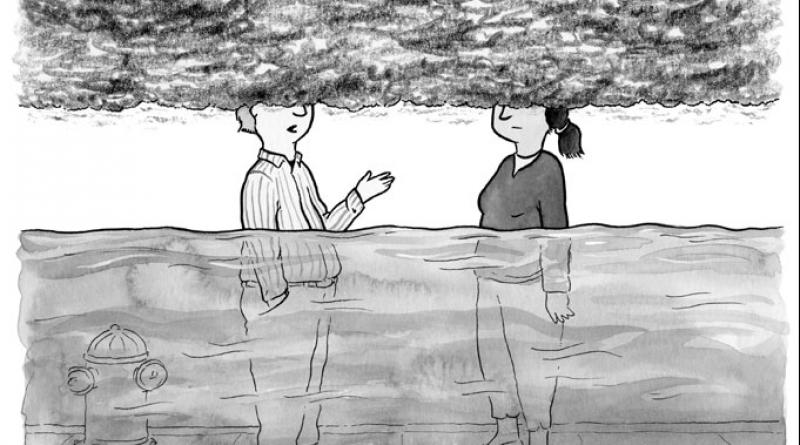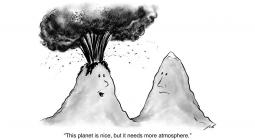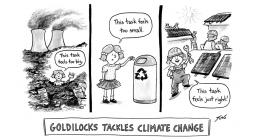ASK SARA: 'Where should I move to be safe from climate change?'

No place on Earth is immune from the consequences of climate change, but some regions will fare better than others.
Dear Sara,
I live in Tucson, Arizona. I’m not sure how many more years we will be able to continue to live here semi-comfortably. As it is, the summers here are hard. Summer lasts May through September. It gets up to 114 degrees on really hot days. With the upward trend being what it is, by 2030 (or sooner?). I don’t know if it will be feasible to continue to live here. Is there a map or other reference we can use to identify other places in the U.S., Mexico, or Canada to move to that will be relatively sheltered from extreme heat or flooding?
– C. in Tucson
Dear Sara,
What town, city, state will be least affected by climate change considering both weather and economic impacts?
– Tom O.
Dear Sara,
I’ve lived in the Southeast most of my life and currently live in Nashville, Tennessee. Between the weather changing and getting older with reduced tolerance to heat, my wife and I are looking for a summertime retirement spot in Canada. My concerns are that the eastern-most option has seemingly endless access to water and waterways, but may have a higher threat of severe weather (hurricanes, flooding, etc.). The British Columbia locations seem less likely to have extreme weather events but also seem more susceptible to clean water shortages and extreme summer heat. What are your thoughts?
– G. in Nashville
Dear Sara,
I love Miami Beach. I love living in Miami Beach. I know the sea is rising. Can I buy an apartment here? If I can’t live here, where can I live?
– E. in Miami Beach
Dear correspondents,
I’m publishing your messages together to show you that you’re not alone in asking these questions. As a group, you’ve identified many of the factors that are making places around the world less safe, including sea-level rise, severe heat waves, and extreme weather.
No place on Earth is immune from the consequences of climate change, but some will fare better than others. So where should you live? Start by taking a second look at the place where you live now.
Consider standing your ground
I’m assuming that all of you reside in the United States, so let’s put things into perspective. Compared to other regions of the world, many parts of the U.S. are well-positioned to cope with the consequences of climate change, in part because of this country’s vast farmland, technological prowess, relative stability, and riches – though keep in mind that wealth inequality is vast and growing.
What’s more, moving to a new place strips you from the web of social connections in your community. As journalist Madeline Ostrander has observed, such ties help people cope during emergencies: “Sense of place, community, and rootedness aren’t just poetic ideas. They are survival mechanisms,” she has written.
So before you pack your bags, first make sure you understand the expected consequences of climate change where you live now. Do those risks outweigh the cost of leaving behind friends, neighbors, family, and professional contacts?
U.S.-based readers will find these resources useful:
- A brief overview of how climate change is expected to affect each U.S. region
- An interactive tool that will enable you to look up how many hot days your city or a city near you could experience during future summers
- An interactive map that shows you what your city’s climate is likely to feel like in 60 years by comparing it to the present-day climate of another city
- Maps that show where wildfires have burned recently and which places are most at risk
- An article on how climate change could affect air quality
- An interactive tool that shows how sea-level rise could affect coastal areas
- A map that shows how precipitation in your region is expected to change in the future
- You can also explore projected changes in precipitation and temperature by ZIP code using this interactive tool.
Learn about your community’s capacity for resilience
In addition to understanding the threats to your home region, it’s important to consider how effectively your community can react to climate-related stresses and disasters. For example, some cities are responding to more-frequent heat waves by planting trees, installing cool pavement, and opening cooling centers for residents.
Find out whether your local leaders have developed any such plans. Try searching online for “your town’s name” or “your state’s name” and “climate action plan” or “sustainability plan.” You can also explore this report that ranks 100 cities on their vulnerability to climate risks and readiness to recover from disasters.
If your community doesn’t have a plan for adapting to climate change – or if you’re not satisfied with your community’s plan – could you do something about that? A think tank called the Post-Carbon Institute offers online courses and step-by-step guides for people who want to work with their neighbors to build community resilience. And if you’re lucky enough to own a home, consider renovations that could help it withstand high heat, floods, and other extreme weather.
Where to go if you really need to go
Some people have little choice but to move. The residents of Newtok, Alaska, for example, are relocating because melting permafrost and increasing erosion have caused portions of their village to wash away. After wildfire incinerated Paradise, California, insurance companies declined to renew policies for some homes in the area. And rising sea levels have sparked warnings that the value of some coastal properties could collapse.
If you’re not comfortable with the risks your community is facing, the resources I listed above can help you evaluate new places to live. If you’re looking outside of the U.S., these maps will help you understand the climate-related threats to Canada and Mexico.
In general, you will want to look for regions that are sheltered from sea-level rise, hurricanes, wildfires, extreme drought, and heat. Within the U.S., portions of the upper Midwest and the Northeast look promising in that regard. In fact, some cities in those regions, such as cold and snowy Buffalo, New York, and Duluth, Minnesota, are in the early stages of preparing to serve as havens for climate refugees. Officials in Duluth are even considering a slogan: “Climate-proof Duluth.”
So if you want to escape from scorching heat, fire, or sea-level rise, you have options. But you may need to invest in a snow shovel.
– Sara
YALE




